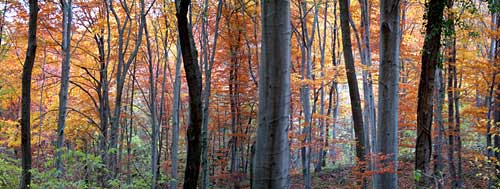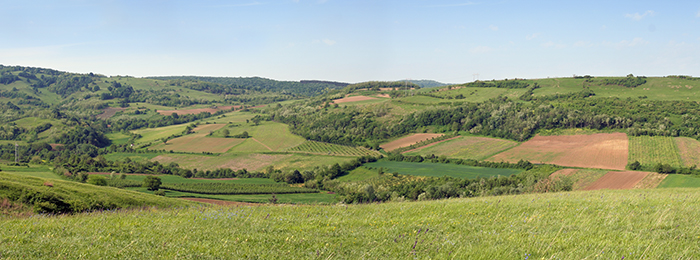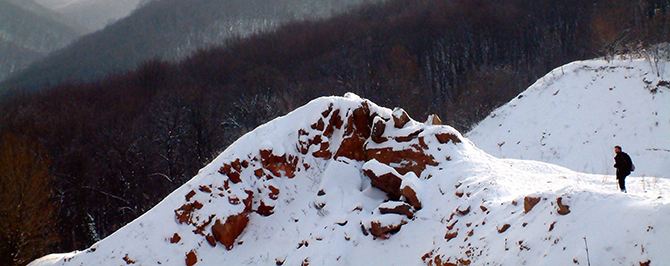
Plants
Flora
Flora at Fruska gora mountain is very diverse and specific.
There are about 1500 flora species growing on the protected zone of national park. This amount of different flora species is characteristic for higher mountains of Serbia than Fruska gora.
Fifteen (Anthyrium, Asplenium, Cheilanthes, Cystopteris, Dryopteris, Gymnocarpium etc.) genus of ferns (Pteridophyta) vegetate on Fruska gora. Among them are 6 natural rarities in Serbia. The numerous genus are Equisetum (6 species) and Asplenium (7 species), and the most prevalent among them are Dryopteris filix-mas, Polystichum aculeatum and Asplenium adianthum-nigrum.
Angiosperms (Angiospermae) are the most numerous plants on Fruska gora, making more than 90 % of whole flora population. The bigest number of species have families Ranunculaceae, Apiaceae, Scrophulariaceae, Lamiaceae, Rosaceae, Fabaceae and Asteraceae (among dicotyledons ) and Liliaceae, Orchidaceae and Poaceae (among monocotyledons). Many of them, 36 dicotyledons and 27 monocotyledons, are protected species in Serbia as a natural rarities.
Vegetation
The Fruska gora in terms of vegetation represents a forest area with varied types of climatogenous forest communities. The forests cover about 90 % of the total surface of the National Park. As a rule, they are polydominant and of great vegetation diversity.
The dominant forests are mesophillous mixed forests of sessile oak (euercus penea) and European hornbeam (Carpinus betulus), orographically conditioned beech forests, as well as thermophilous forests of Turkey oak (Quercus cerris), pubescent oak (Q. pubescens) and (Q. farnetto).
The climatogenous type of forest in the Fruska gora is the sessile oak forest with butcher's-broom (Aculeato-Querco Carpinetum serbicum Jov.) being a Seographical variant of the oak-hornbeam phytocenosis of Serbia (Querco-Carpinerum serbicum Rud) with Mediterranean elements. The sessile oak forest with fescue (Festuco montanae-Quercetum petreae Jnnl) is a specific forest community and is also a climato-oro-pedogcnous type of the Fruska gora forest. A significant share of the silver linden (Tilia tomentosa) is a special feature of the forest phytocenoses in the Fruska gora, conditioned by the climate in the border areas of the Pannonian Plain.
The following stands of the autochthonous forest communities have been protected as nature monuments: The stand of different oaks and European hornbeam with the silver linden, the stand of beech and silver linden with the European hornbeam, the stand of black alder and the stand of walnut. According to former, old fashioned beliefs that allochthonous species contribute to the landscape beauty, the stands of allochthonous tree species have been put under protection, as well.
As opposed to the forest vegetation, the herbaceous vegetation of the Fruska gora has been significantly less studied. There are some data about the steppe vegetation, particularly of the eastern part of the Fruska gora and of the Fruska gora loess plateau. The other types of herbaceous vegetation, such as marshy phytocenoses of brook valleys and vegetation of meadows and pastures have not been studied at all, so these researches should be organized in the National Park. Habitats of the steppe vegetation have mostly been turned into plow land, and the steppe phytocenoses have been pushed out to the border areas and slopes of loess plateau.
The main steppe association of the Fruska gora is Anulo - Chrysopogonen grilli, more widespread in its eastern region and generally on the lower slopes of the eastern and northern parts of this island mountain. This phytocenosis has a rich floristic composition, with a large number of rare and endemic plants classified as natural rarities, which are characteristic species of the association: Inula ensifolia, Stipa pulcherima, Linum flavum, Aster amellus, Dictamnus albus and many others.
The Fruska gora region is peculiar for the community of Crambo-Artemisietum campestris of a very small distribution area, with only one finding place in the eastern part of the Fruska gora. It is characterized by number of steppe relics: Crambe tataria, Vinca herbacea, Adonis vemalis, Anemone pulsatilla, Iris pumila, Veronica spuria and others, so it is as a whole of a relic character.
The spread of these communities show that there is a justifiable scientific basis for the expansion of the National Park to the lower, steppe and forest-steppe areas on a loess soil.








